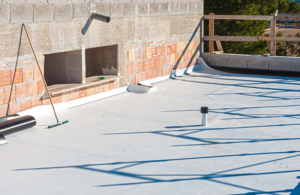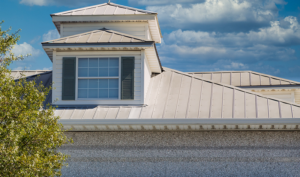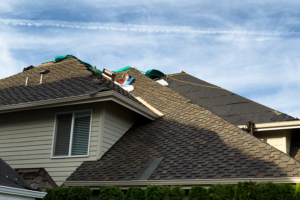Understanding the signs of roof storm damage can be very helpful when consulting with a roofing professional and insurance company, especially if you may have an insurance claim. Hail and wind damage are two of the most common and most expensive types of damage, especially to shingle roofs. Some signs are obvious, but there are others that you will have to do a careful roof inspection to find signs of damage.
Here are some critical signs:
1. Look on the Ground
There is a misconception that damage can only be seen from the roof. While you can see the extent of the damage from a roof inspection, you can also tell a lot from the ground. This is especially true after a strong wind associated with a storm. If you have asphalt shingles, you are likely to see evidence of granule loss on the ground. Granulate are the small rock-like particles sprinkled over asphalt shingles to help protect them from UV rays. If there are still signs of hail on the ground, and particularly large hail size, you know your roof has taken some punishment.
2. How are Your Gutters Looking, and working?
After a storm, one of the best things you can do is examine your gutters. If they are leaky and clogged with either shingle material or other debris (especially tree branches) this may indicate roof damage as well. Hail damage and wind damage are primary causes of leaks. Once the leaking starts mold follows. Needless to say, it is better to act sooner than later to get the problem under control.
Aside from leaks and clogs to your gutters, severe storm damage, especially damage from hail, can cause pieces of your gutter to be torn loose. Even if whole sections are not missing, bending, leaking, and sagging are signs your roof may have been damaged and that you need professional repairs from a roofing contractor.
While you are inspecting gutters after severe weather, especially a hail storm, check the downspouts for pieces of wood shingles if your house has those, or a build up of shingle granules. Both of which can indicate cracked shingles. Even with an untrained eye, evidence of roofing materials in your downspouts is an obvious sign.
3. Your Shingles Have Been Damaged
Shingles are your primary water shedding surface. Look at your roof shingles closely since this will give you a good indication of any damage. If your shingles are cracked, splitting, or curled and torn, then roof repair is needed. Hail damage is a particularly potent cause of shingle damage. If such a storm has occurred it is often advisable to consult a qualified contractor since there may be damage to the underlying material as well, in which case roof repair, or even roof replacement, will be required to prevent interior damage. At this point you may consider an insurance claim.
You may also see shingles scattered at ground level. Usually, these cannot successfully go back on the roof. Any attempts to try a roof repair patch with these shingles will often result in further damage to your roof and siding. Horizontal lines in shingles are also signs of heavy winds. If this is wide spread you may need to consider roof replacement because the shingle seal has been broken. After a storm has passed you can look up the wind speed in your area as an indication of what to expect. Besides hail, ice storms can create temporary ice dams that break the adhesive seal in shingles creating a path for water intrusion. Signs of wind damage may be easier to spot but damage to roof shingles from temporary ice dams may require a professional roofing contractor to find.
4. Water Damage
Once you have suffered roof storm damage, especially damage from hail, you are likely to see interior signs of water damage. You may start seeing dark, wet spots on the wall. or water spots indicating a water leak from pooled water or only during rain events from a roof leak. This is also a time to contact your homeowners insurance company.
If you have drywall, it may start to flake or crack. Wet spots around your pipes and taps can also occur. Damage under a roof deck can sometimes be hard to spot and lead to interior water intrusion, and this can happen after roof damage and especially after roof hail damage. One sign of a problem is a musty, moldy smell inside the house. Respiratory illnesses can be aggravated by mold in the living areas or your home.
5. Attic Damage
Attic damage is common if there is damage to roof underlayment and especially from hail damage. If you notice accumulated water, drips, stains, or wet insulation, then there has been roof damage. Especially when there is hail damage to roof structural elements, check the framing. If it is wet, then you can be sure the roof has lost some structural integrity. Damage from wind can result in structural damage both during and after an event causing roof damage, which may be found during an attic inspection.
6. Beneath the Surface
So far, we have looked at the damage to the shingles on your roof, but there may also be more serious damage from a storm. This damage is the kind a professional can detect.
There is a layer under your shingles called an underlayment, and this is what will temporarily protect you from the rain and other elements. Underlayment damage cannot wait. It needs to be fixed right away.
A professional will also check your roof decking if you have it. While this may seem like it has nothing to do with the roof, this is actually not the case. The decking is attached to rafters, which creates the foundation of your roofing system.
7. Chimney Damage
You need to fix roof damage from a storm immediately, especially if you have a chimney. An un-repaired roof that begins to leak is likely to cause chimney problems. Damage to your chimney can cause the structure of your chimney to deteriorate, and when this happens, the chimney may become unsafe. Hail damage, leading to water damage, will make the chimney unstable and you are also likely to find mold damage overtime.
8. Debris and Debris Impact
One common thing that can happen in a storm is trees and plants can be torn down. Often there is a lot of tree damage after a storm and if your roof has a lot of debris over it, especially if this debris includes heavy tree limbs, it is very likely that your roof has been damaged. Damage to the siding is also one of the possible signs of storm damage to the roof.
When and if you remove debris to do a closer examination, you should be careful. This is because you may tear loose shingles that have become entangled in the debris. Once you have gotten the debris cleared, you will need to ensure that you trim your trees regularly so they are not hanging over your roof.
Time to Get Fixed Up
Now that you are aware of what roof damage looks like. It’s time to think about storm damage repair. Make sure your contractor is willing to work with your insurance agent to come up with an accurate and comprehensive estimate of repairs and avoid companies that are simply storm chasers. They are often unresponsive if the work proves unsatisfactory.
Blue Nail Roofing has a Master Elite contractor status awarded by the largest roofing manufacturer in North America, GAF. Only 2% of contractors in the US meet the rigorous standards to achieve this status, which means you can be assured you are making a smart choice when you select the professionals at Blue Nail to execute your home and business roofing repairs. Call today to schedule a professional evaluation!
If you need a professional roofing contractor with a commitment to customer service, do not hesitate to contact us.







